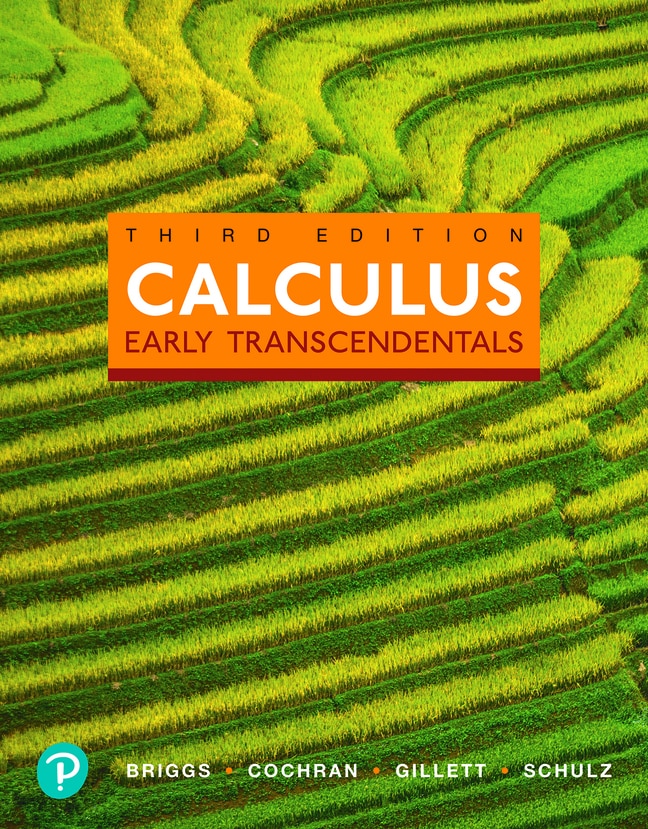
Calculus: Early Transcendentals, 3rd edition
- William L. Briggs
- , Lyle Cochran
- , Bernard Gillett
- , Eric Schulz

- Watch and learn
Videos & animations bring concepts to life
- Listen on the go
Learn how you like with full eTextbook audio
- Find it fast
Quickly navigate your eTextbook with search
- Stay organized
Access all your eTextbooks in one place
- Easily continue access
Keep learning with auto-renew
Calculus: Early Transcendentals builds from a foundation of strong exercise sets, then draws you into the narrative through writing that reflects an instructor's voice. Examples are stepped out and thoroughly annotated, and figures are designed carefully to work with the content. The 3rd Edition introduces important advances and refinements while retaining its proven hallmark features. Extensively revised exercise sets are rearranged and relabeled, with some modified and other new ones added. Chapter Review exercises are thoroughly revised to provide more exercises, more intermediate-level problems, and more opportunities to choose a strategy of solution.
Published by Pearson (September 1st 2020) - Copyright © 2021
ISBN-13: 9780136880677
Subject: Calculus
Category: Calculus
1. Functions
- 1.1 Review of Functions
- 1.2 Representing Functions
- 1.3 Inverse, Exponential, and Logarithmic Functions
- 1.4 Trigonometric Functions and Their Inverses
- Review Exercises
2. Limits
- 2.1 The Idea of Limits
- 2.2 Definitions of Limits
- 2.3 Techniques for Computing Limits
- 2.4 Infinite Limits
- 2.5 Limits at Infinity
- 2.6 Continuity
- 2.7 Precise Definitions of Limits
- Review Exercises
3. Derivatives
- 3.1 Introducing the Derivative
- 3.2 The Derivative as a Function
- 3.3 Rules of Differentiation
- 3.4 The Product and Quotient Rules
- 3.5 Derivatives of Trigonometric Functions
- 3.6 Derivatives as Rates of Change
- 3.7 The Chain Rule
- 3.8 Implicit Differentiation
- 3.9 Derivatives of Logarithmic and Exponential Functions
- 3.10 Derivatives of Inverse Trigonometric Functions
- 3.11 Related Rates
- Review Exercises
4. Applications of the Derivative
- 4.1 Maxima and Minima
- 4.2 Mean Value Theorem
- 4.3 What Derivatives Tell Us
- 4.4 Graphing Functions
- 4.5 Optimization Problems
- 4.6 Linear Approximation and Differentials
- 4.7 L'Hôpital's Rule
- 4.8 Newton's Method
- 4.9 Antiderivatives
- Review Exercises
5. Integration
- 5.1 Approximating Areas under Curves
- 5.2 Definite Integrals
- 5.3 Fundamental Theorem of Calculus
- 5.4 Working with Integrals
- 5.5 Substitution Rule
- Review Exercises
6. Applications of Integration
- 6.1 Velocity and Net Change
- 6.2 Regions Between Curves
- 6.3 Volume by Slicing
- 6.4 Volume by Shells
- 6.5 Length of Curves
- 6.6 Surface Area
- 6.7 Physical Applications
- Review Exercises
7. Logarithmic, Exponential, and Hyperbolic Functions
- 7.1 Logarithmic and Exponential Functions Revisited
- 7.2 Exponential Models
- 7.3 Hyperbolic Functions
- Review Exercises
8. Integration Techniques
- 8.1 Basic Approaches
- 8.2 Integration by Parts
- 8.3 Trigonometric Integrals
- 8.4 Trigonometric Substitutions
- 8.5 Partial Fractions
- 8.6 Integration Strategies
- 8.7 Other Methods of Integration
- 8.8 Numerical Integration
- 8.9 Improper Integrals
- Review Exercises
9. Differential Equations
- 9.1 Basic Ideas
- 9.2 Direction Fields and Euler's Method
- 9.3 Separable Differential Equations
- 9.4 Special First-Order Linear Differential Equations
- 9.5 Modeling with Differential Equations
- Review Exercises
10. Sequences and Infinite Series
- 10.1 An Overview
- 10.2 Sequences
- 10.3 Infinite Series
- 10.4 The Divergence and Integral Tests
- 10.5 Comparison Tests
- 10.6 Alternating Series
- 10.7 The Ratio and Root Tests
- 10.8 Choosing a Convergence Test
- Review Exercises
11. Power Series
- 11.1 Approximating Functions with Polynomials
- 11.2 Properties of Power Series
- 11.3 Taylor Series
- 11.4 Working with Taylor Series
- Review Exercises
12. Parametric and Polar Curves
- 12.1 Parametric Equations
- 12.2 Polar Coordinates
- 12.3 Calculus in Polar Coordinates
- 12.4 Conic Sections
- Review Exercises
13. Vectors and the Geometry of Space
- 13.1 Vectors in the Plane
- 13.2 Vectors in Three Dimensions
- 13.3 Dot Products
- 13.4 Cross Products
- 13.5 Lines and Planes in Space
- 13.6 Cylinders and Quadric Surfaces
- Review Exercises
14. Vector-Valued Functions
- 14.1 Vector-Valued Functions
- 14.2 Calculus of Vector-Valued Functions
- 14.3 Motion in Space
- 14.4 Length of Curves
- 14.5 Curvature and Normal Vectors
- Review Exercises
15. Functions of Several Variables
- 15.1 Graphs and Level Curves
- 15.2 Limits and Continuity
- 15.3 Partial Derivatives
- 15.4 The Chain Rule
- 15.5 Directional Derivatives and the Gradient
- 15.6 Tangent Planes and Linear Approximation
- 15.7 Maximum/Minimum Problems
- 15.8 Lagrange Multipliers
- Review Exercises
16. Multiple Integration
- 16.1 Double Integrals over Rectangular Regions
- 16.2 Double Integrals over General Regions
- 16.3 Double Integrals in Polar Coordinates
- 16.4 Triple Integrals
- 16.5 Triple Integrals in Cylindrical and Spherical Coordinates
- 16.6 Integrals for Mass Calculations
- 16.7 Change of Variables in Multiple Integrals
- Review Exercises
17. Vector Calculus
- 17.1 Vector Fields
- 17.2 Line Integrals
- 17.3 Conservative Vector Fields
- 17.4 Green's Theorem
- 17.5 Divergence and Curl
- 17.6 Surface Integrals
- 17.7 Stokes' Theorem
- 17.8 Divergence Theorem
- Review Exercises
D2 Second-Order Differential Equations ONLINE
- D2.1 Basic Ideas
- D2.2 Linear Homogeneous Equations
- D2.3 Linear Nonhomogeneous Equations
- D2.4 Applications
- D2.5 Complex Forcing Functions
- Review Exercises
Appendices
- Proofs of Selected Theorems
- Algebra Review ONLINE
- Complex Numbers ONLINE